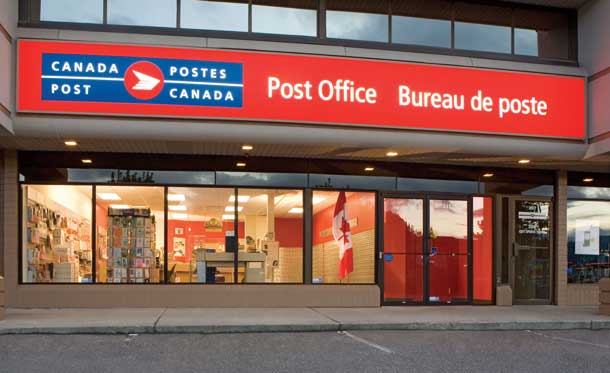
Canada Post $1 Per Stamp, Less Home Delivery
OTTAWA – Canada Post is continuing to evolve during the digital age. The post office is slowly shifting toward a different business model. That is meaning changes at the Crown Corporation that will raise the price of stamps for a letter from $1.00 to $0.85. It will a
Canada Post unveiled five initiatives that together will form the foundation of a new postal system designed to serve busy Canadians and meet their changing needs for postal services. It will also open new opportunities to businesses that are redefining how they connect and serve customers in an increasingly digital world. These changes will begin taking effect in the new year.
This comprehensive plan can be achieved without any changes to the Canadian Postal Service Charter. The integrated plan’s five main initiatives are:
1. Community mailboxes
Over the next five years, the one third of Canadian households that receive their mail at their door will be converted to community mailbox delivery. This change will provide significant savings to Canada Post and will have no impact on the two thirds of Canadian households that already receive their mail and parcels through community mailboxes, grouped or lobby mailboxes or rural mailboxes. Community mailboxes have advantages for busy Canadians as they offer individually locked mail and small packet compartments as well as locked compartments for securely receiving parcels. The initial neighbourhoods slated for conversion in the second half of 2014 will be announced once plans are finalized. The transition is expected to take 5 years to complete on a national scale.
2. A new approach to pricing Lettermail to take effect March 31, 2014
Canada Post will introduce a new tiered pricing structure for Lettermail mailed within Canada, which will better reflect the cost of serving various customer segments. Under these changes, the majority of Canadians, because they buy stamps in booklets or coils, will pay $0.85 per stamp, with discounts for customers that use the mail most. The minority of consumers who purchase stamps one at a time, which represents an estimated 2 per cent of stamp purchases, will pay $1 per stamp. The average Canadian household purchases fewer than 2 stamps per month. These stamp price changes will take effect March 31, 2014.1
3. Expanding convenience through postal franchises
Canada Post will strengthen its retail network by opening more franchise postal outlets in stores across Canada. The company will partner with local retail businesses that are conveniently located in the communities they serve and offer added benefits, such as better parking and longer hours. This will allow busy Canadians to do more shopping in one place. Canada Post will also continue to align its corporate post offices to customer traffic patterns.
4. Streamlining operations
Changes to internal operations will make for a more efficient flow of parcels and mail through the network and to the customers. These changes are driven by technology (such as faster computerized sorting equipment), consolidation (such as processing mail and parcels in a central location) and providing more delivery employees with fuel-efficient vehicles, so the same employee can deliver both mail and parcels. Improved operations will yield cost-effective and more reliable delivery to Canadians, along with better parcel tracking capabilities.
5. Addressing the cost of labour
Canada Post is changing its business model and, as a result, will require fewer employees to serve the future needs of Canadians. With its current labour costs, Canada Post has a much higher cost structure than its competitors in the private sector have. This is simply not sustainable. The company will continue to bring the cost of labour in line with its competitors through attrition and collective bargaining over time. The average age of current employees is 48 and Canada Post expects nearly 15,000 employees to retire or leave the company over the next five years. This is more than enough to allow for the reduction of between 6,000 and 8,000 positions, mainly through attrition. Canada Post will also take the necessary steps to permanently address the sustainability of its pension plan. A leaner workforce will create a more flexible and competitive Canada Post, able to respond quickly to the changing marketplace.
Canada Post has a mandate to fund its operations with revenues from the sale of its products and services, rather than become a burden on taxpayers. With the increasing use of digital communication and the historic decline of Lettermail volumes, Canada Post has begun to post significant financial losses. If left unchecked, continued losses would soon jeopardize its financial self-sufficiency and become a significant burden on taxpayers and customers. In April 2013, a Conference Board of Canada study projected a financial loss of close to $1 billion by 2020 unless Canada Post makes fundamental changes to its business. A projection of that magnitude was directionally consistent with Canada Post’s own projections.
The implementation of this plan means Canada Post can return to financial sustainability by 2019. Once fully implemented, four of the five initiatives are expected to generate financial benefits with an estimated combined worth of $700 million to $900 million per year.2 Those figures do not include the significant annual savings expected in labour costs and from restructuring the pension, because these are yet to be addressed through future rounds of collective bargaining. The range in the combined benefits forecasted reflects the need for more detailed planning and the difficulty of accurately forecasting the pace at which Lettermail volumes will erode. Canada Post has factored in significant erosion.
The Government of Canada has informed Canada Post of its intent to provide temporary pension relief from the need to make special payments, including solvency payments estimated at $1 billion in 2014 alone. Along with the new Lettermail pricing, this measure will address the immediate need for additional liquidity by mid-2014, which was outlined in Canada Post’s most recent financial reports. During the relief period, Canada Post will act with urgency to restructure the pension plan in order to ensure its long-term sustainability.
The postal service of the future will reflect and serve Canadians’ new postal needs. As more people began to communicate and manage their household bills online, Lettermail volumes declined sharply. Yet as more people shopped online, parcel volumes shot up. This dramatic shift is creating a pressing need to manage a greater number of parcels and less mail with more valuable items. (These items include credit and loyalty cards and government-issued cards and licences.) This shift provided clear direction to Canada Post and the many businesses looking to redefine customer experience in an increasingly digital world.






